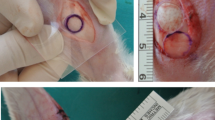Abstract
Background
Cartilage grafts are commonly used in nasal surgery for structural and/or esthetic purposes. The viability of cartilage grafts has been investigated in many forms since the use of cartilage grafts in surgical procedures.
Objectives
The objective of this study was to investigate the viability of minced cartilage grafts and whether there is a difference between grafts wrapped in Surgicel® Original and Surgicel Fibrillar.
Methods
A total of ten New Zealand rabbits were used for the study. Cartilage grafts were harvested from one side ear. Four groups were formed. Group 1: minced cartilage graft wrapped in Surgicel Fibrillar; Group 2: minced cartilage graft wrapped in Surgicel Original; Group 3: bare minced cartilage graft; and Group 4: bare diced cartilage graft. Four small subcutaneous pockets were made in the backs of the rabbits, and the grafts were placed in these pockets. All of the rabbits were sacrificed at the end of 3 months, and the samples were collected. The sections were stained with hematoxylin and eosin (H&E), toluidin blue, safranin-O, masson trichrome, and glial fibrillary acidic protein immunohistochemical. All specimens were assessed histopathologically under a light microscope.
Results
There was no statistically significant difference between the Surgicel Fibrillar and Surgicel Original groups with respect to any of the parameters. Bone formation, calcification, inflammation, fibrosis, and basophilia were similar in all groups, with no significant difference among them. In the Surgicel Fibrillar and Surgicel Original groups, a heavy chondrocyte nucleus loss accompanied by a minimal peripheral proliferation was observed.
Conclusions
The viability of bare minced cartilage grafts was found to be similar to that of bare diced cartilage in this study. Minced cartilage grafts can be used in the correction of minor dorsal defects and irregularities in persons with thin nasal skins, especially in primary and revision rhinoplasty. Although there is no statistically significant difference between the Surgicel Fibrillary and Surgicel Original groups, we think that, if it is necessary to use oxidized regenerated cellulose, it should be in the fibrillar form.
No Level Assigned
This journal requires that authors assign a level of evidence to each article. For a full description of these Evidence-Based Medicine ratings, please refer to the Table of Contents or the online Instructions to Authors http://www.springer.com/00266.







Similar content being viewed by others
References
Cakmak O, Bircan S, Buyuklu F, Tuncer I, Dal T, Ozluoglu LN (2005) Viability of crushed and diced cartilage grafts: a study in rabbits. Arch Facial Plast Surg 7:21–26
Brenner KA, McConnell MP, Evans GR, Calvert JW (2006) Survival of diced cartilage grafts: an experimental study. Plast Reconstr Surg 117:105–115
Hizal E, Buyuklu F, Ozer O, Cakmak O (2011) Effects of different levels of crushingon the viability of rabbit costal and nasal septal cartilages. Plast Reconstr Surg 128:1045–1051
Cakmak O, Buyuklu F, Yilmaz Z, Sahin FI, Tarhan E, Ozluoglu LN (2005) Viability of cultured human nasal septum chondrocytes after crushing. Arch Facial Plast Surg 7:406–409
Guerrerosantos J, Trabanino C, Guerrerosantos F (2006) Multifragmented cartilage wrapped with fascia in augmentation rhinoplasty. Plast Reconstr Surg 117:804–816
Parker Porter J (2000) Grafts in rhinoplasty: alloplastic vs autogenous. Arch Otolaryngol Head Neck Surg 126:558–561
Erol OO (2000) The Turkish delight: a pliable graft for rhinoplasty. Plast Reconstr Surg 105:2229–2241
Daniel RK, Calvert JW (2004) Diced cartilage grafts in rhinoplasty surgery. Plast Reconstr Surg 113:2156–2171
Kim HK, Chu LS, Kim JW, Park B, Kim MK, Bae TH, Kim WS (2011) The viability of diced cartilage grafts wrapped in autogenous fascia and AlloDerm® in a rabbit model. J Plast Reconstr Aesthet Surg 64:e193–e200
Firat C, Gurlek A, Aydin NE (2011) Viability of cartilage grafts in various forms. J Craniofac Surg 22:1666–1670
Kazikdas KC, Ergur B, Tugyan K, Guneli E, Kaya D, Sahan M (2007) Viability of crushed and diced cartilage grafts wrapped in oxidized regenerated cellulose and esterified hyaluronic acid: an experimental study. Laryngoscope 117:1728–1734
Yilmaz S, Ercocen AR, Can Z, Yenidünya S, Edali N, Yormuk E (2001) Viability of diced crushed cartilage grafts and the effects of Surgicel [oxidized regenerated cellulose] on cartilage grafts. Plast Reconstr Surg 109:1054–1060
Kayabasoglu G, Ozbek E, Yanar S, Sahin F, Keles ON, Yilmaz MS, Guven M (2015) The comparison of the viability of crushed, morselized and diced cartilage grafts: a confocal microscopic study. Eur Arch Otorhinolaryngol 272:1135–1142
Güler İ, Billur D, Aydin S, Kocatürk S (2015) Efficacy of platelet-rich fibrin matrix on viability of diced cartilage grafts in a rabbit model. Laryngoscope 125:e104–e111
Keshavarzi S, MacDougall M, Lulic D, Kasasbeh A, Levy M (2013) Clinical experience with the surgicel family of absorbable hemostats [oxidized regenerated cellulose] in neurosurgical applications: a review. Wounds 25:160–167
Cardenas-Camarena L, Guerro MT (1999) Use of cartilaginous autografts in nasal surgery: 8 years of experience. Plast Reconstr Surg 103:1003–1014
Hafezi F, Abbaszadeh A, Naghibzadeh B, Ashtiani AK, Fatemi MJ, Nouhi AH (2014) Comparison of outcomes using diced cartilage with or without tensor fascia latae wrapping in rabbits. Aesthet Surg J 34:NP50–NP60
Cakmak O, Buyuklu F (2007) Crushed cartilage grafts for concealing irregularities in rhinoplasty. Arch Facial Plast Surg 9:352–357
Hamra ST (1993) Crushed cartilage grafts over alar dome reduction in open rhinoplasty. Plast Reconstr Surg 92:352–356
Kemaloğlu CA, Tekin Y (2014) A comparison of diced cartilage grafts wrapped in perichondrium versus fascia. Aesthetic Plast Surg 38:1164–1168
Elahi MM, Jackson IT, Moreira-Gonzalez A, Yamini D (2003) Nasal augmentation with Surgicel-wrapped diced cartilage: a review of 67 consecutive cases. Plast Reconstr Surg 111:1309–1318
Author information
Authors and Affiliations
Corresponding author
Ethics declarations
Conflict of Interest
The authors declare that they have no conflict of interest to disclose.
Rights and permissions
About this article
Cite this article
Özkan, A., Topkara, A., Akbulut, M. et al. Survival of Minced Cartilage Grafts with Comparison Surgicel® Original and Fibrillar. Aesth Plast Surg 40, 602–612 (2016). https://doi.org/10.1007/s00266-016-0661-6
Received:
Accepted:
Published:
Issue Date:
DOI: https://doi.org/10.1007/s00266-016-0661-6




